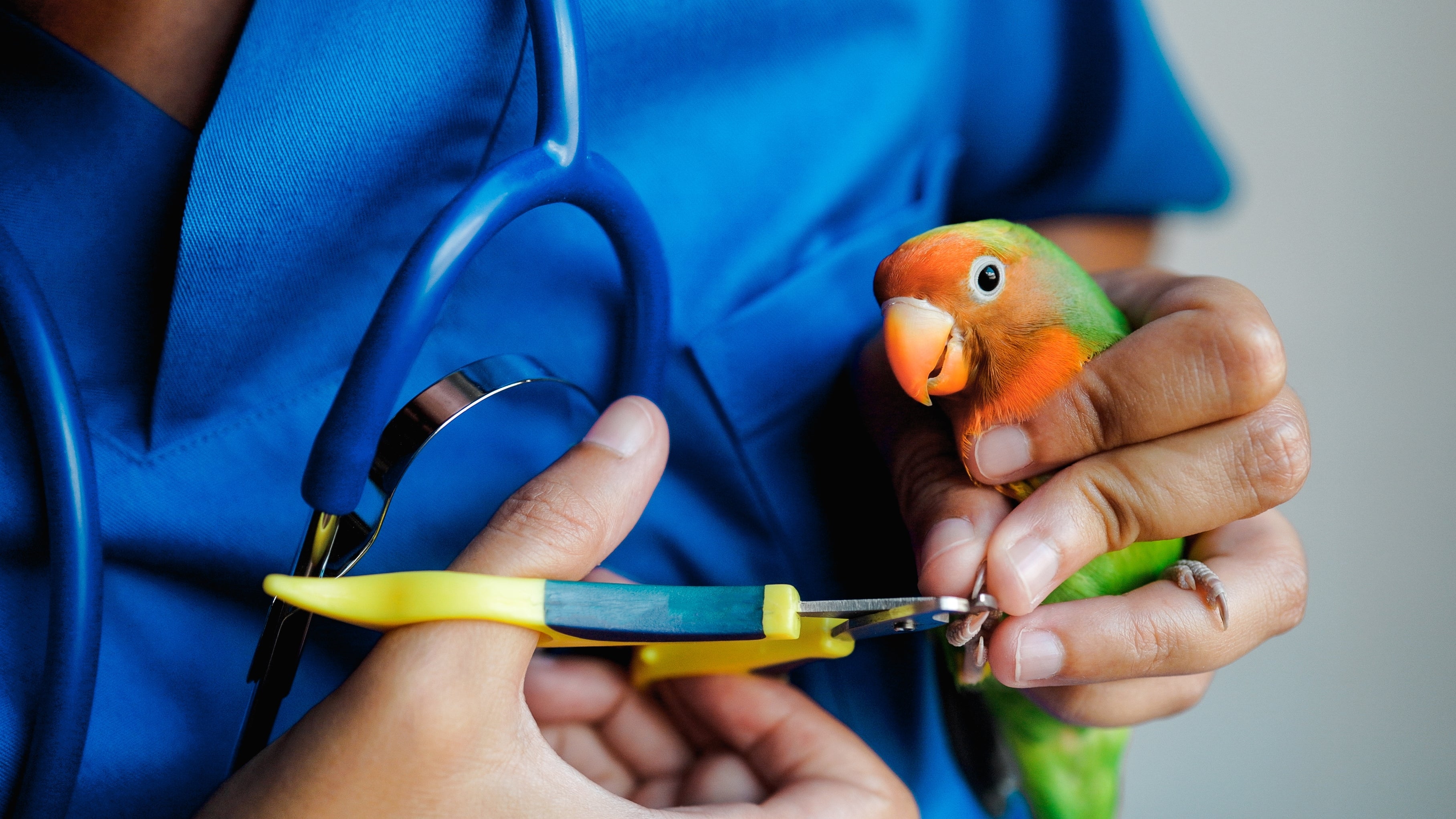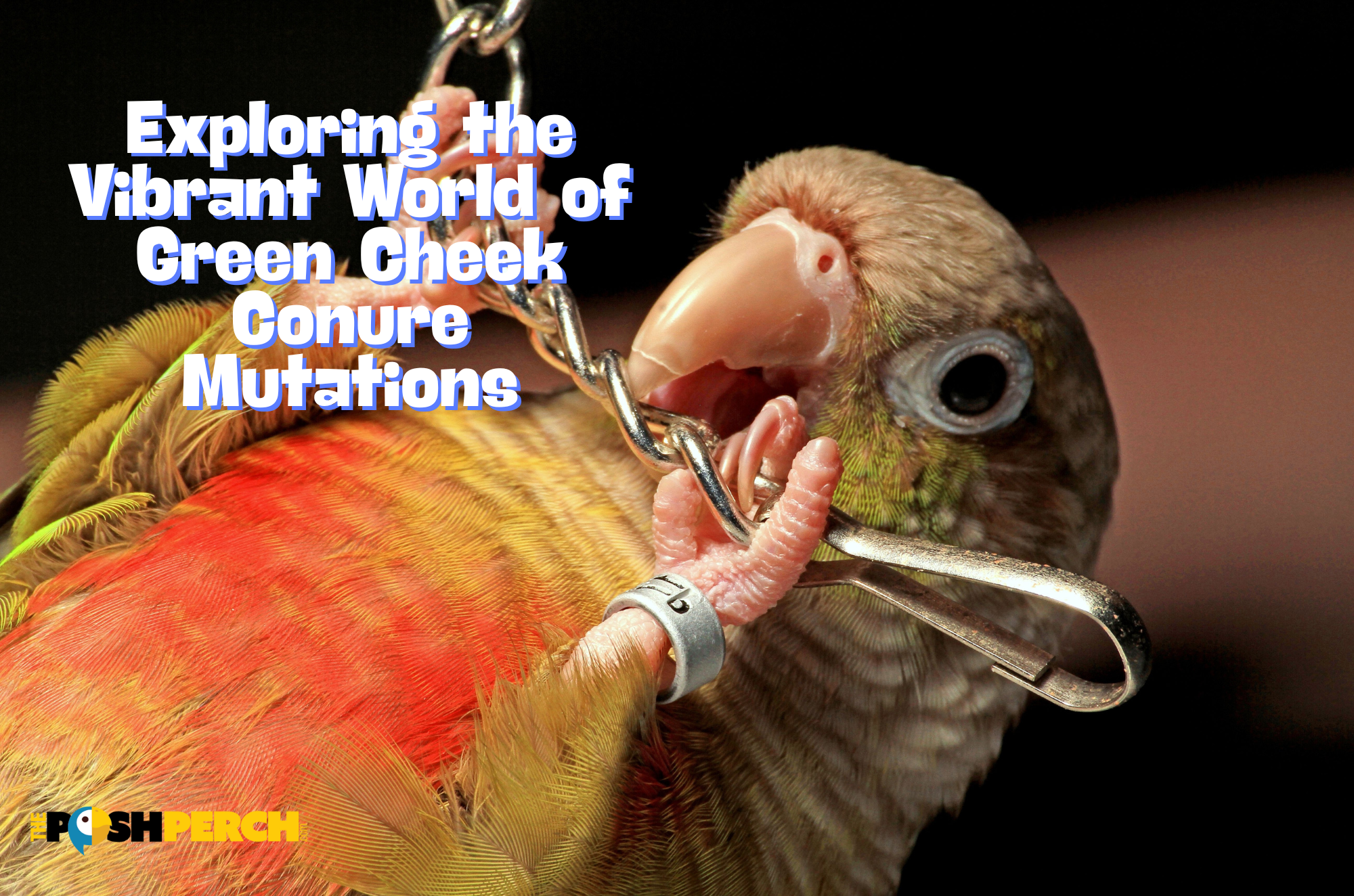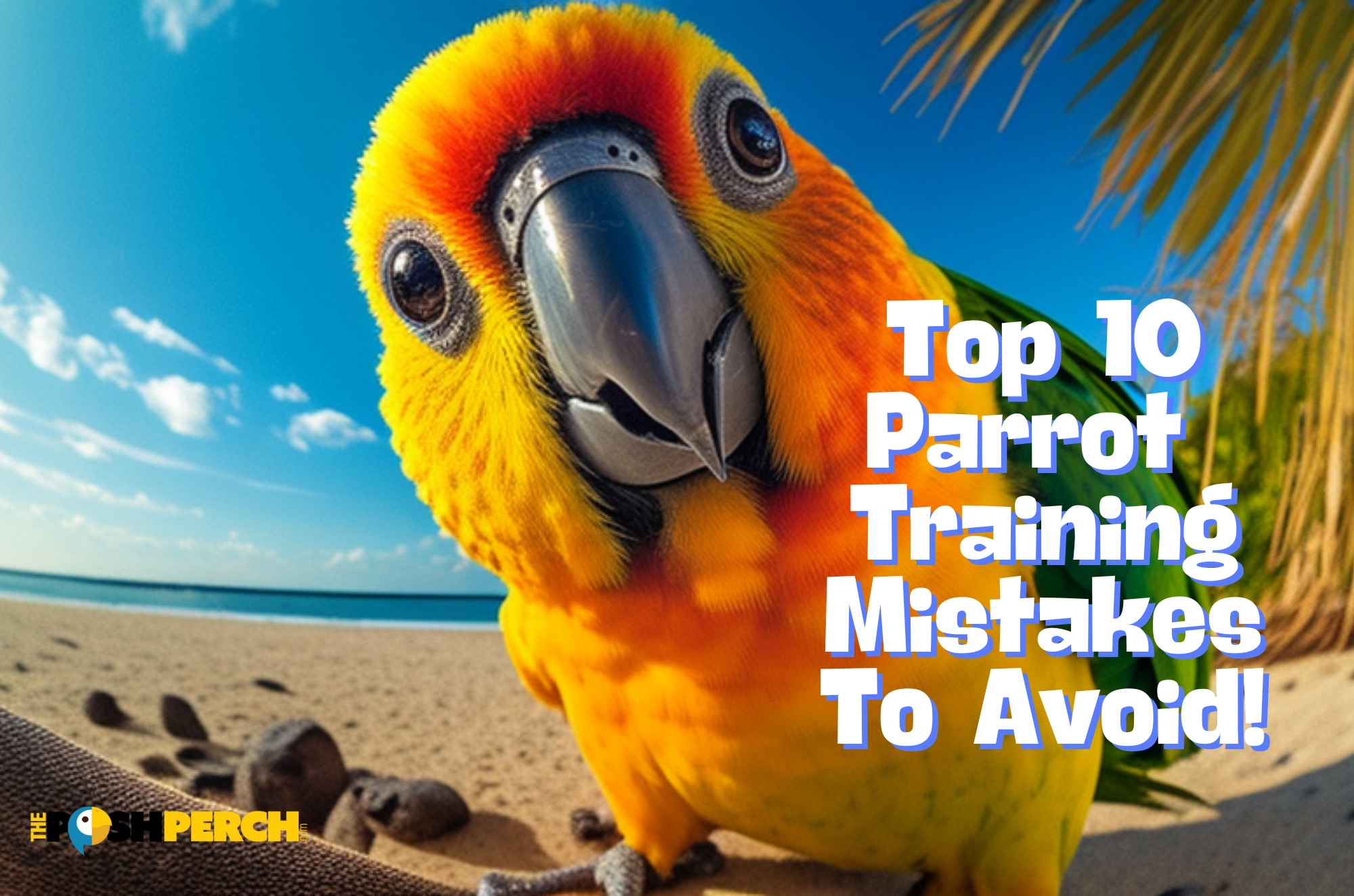
How Do I Stop My Parrot From Biting?
16 min reading time

16 min reading time
Understanding the reason for your parrot's biting behavior is the first step in addressing and correcting the behavior. Some common reasons that parrots bite include:
Fear: Parrots may bite when they feel threatened or frightened. This can be due to loud noises, unfamiliar people or animals, or a change in their environment.
Aggression: Some parrots may exhibit aggressive biting behavior as a means of asserting dominance or territorial behavior. This can be seen when the parrot is trying to protect its food, toys or cage from others.
Playfulness: Parrots are naturally curious and playful animals and may bite as a form of play or exploration. They may also bite as a way to test the boundaries of their relationship with you.
Attention-seeking: Parrots may bite simply to get your attention. This can be the case when the parrot feels neglected or is not getting enough interaction or stimulation.
By understanding the reason behind the biting, you can tailor your approach to address the behavior more effectively. For example, if your parrot is biting out of fear, you may need to work on building its trust and confidence through positive reinforcement and gradual socialization. If the biting is due to aggression or territorial behavior, you may need to establish clear boundaries and rules for the bird. In the case where the parrot biting is due to lack of attention and stimulation, providing more toys and activities for the parrot and dedicating more time for interaction and training can help.
It is important to note that if your parrot is biting out of pain or discomfort, it is highly recommended to consult an avian veterinarian to rule out any health issues.
Positive Reinforcement
Positive reinforcement is a powerful tool in modifying behavior in parrots, as it encourages the bird to repeat the desired behavior in order to receive a reward. When your parrot exhibits non-biting behavior, such as sitting quietly on its perch or stepping up onto your hand, you should immediately reward it with a treat or a verbal praise such as "good bird". This will teach the parrot that this behavior is desirable and will be reinforced with a reward.
It is important to use a high-value treat, such as a small piece of fruit or a favorite treat, as a reward for the bird, so it associates the behavior with a desirable outcome. Timing is also crucial when using positive reinforcement. The reward should be given immediately after the desired behavior is exhibited, as this will help to solidify the connection between the behavior and the reward in the parrot's mind.
It's also essential to be consistent when providing positive reinforcement, so the parrot learns that the desired behavior will be rewarded every time it is performed. Over time, the parrot will begin to exhibit the desired behavior more frequently as it associates it with a positive outcome.
Using positive reinforcement in conjunction with other training techniques such as teaching commands, providing plenty of toys and activities, and socialization with human will reinforce the positive behavior even more.
It's also important to note that positive reinforcement should not be used in cases of aggression or fear-based biting as it may inadvertently reinforce the fear and the aggressive behavior. In these cases, it's best to consult with a professional for guidance on how to handle the situation.
Training Your Parrot
Training your parrot to respond to simple commands can help to establish a positive relationship between you and your parrot, as well as reduce biting behavior. Teaching your parrot simple commands such as "step up," "step down," and "come" can help to create a clear line of communication between you and your bird.
"Step up" and "step down" commands are useful for training your parrot to move from one place to another, such as moving from its cage to your hand or perch. This can help to prevent biting behavior when the bird needs to be moved or handled.
"Come" command is also important because it helps to create a positive association between the bird and its owner. When the parrot comes to you, it will be rewarded with positive reinforcement such as a treat or a verbal praise. Over time, the parrot will start to associate coming to you as a positive experience and will be less likely to bite when it is near you.
It's important to be consistent and patient when training your parrot. Start by training your parrot one command at a time and practice it frequently until the bird has mastered it before moving on to the next command. Use positive reinforcement such as treats, praise, or petting to reward the parrot for following the command correctly.
Consistency is key in training a parrot, make sure that everyone who interacts with the bird follows the same commands, so the bird doesn't get mixed signals.
In addition to commands training, teaching your parrot to do tricks can also help to establish a positive relationship and reduce biting behavior. Parrots are highly intelligent animals and enjoy learning new things. Teaching your parrot to do tricks can provide mental stimulation, and it also can be a fun bonding experience.
As a general rule, remember that the more time you invest in training your parrot, the more rewards you'll see in terms of improved behavior.
Reducing Stress and Boredom
Parrots may bite out of stress or boredom, and it's important to address these underlying issues to help reduce biting behavior.
Boredom can be a major issue for parrots that are not provided with enough stimulation. Parrots are intelligent, curious animals and require a variety of toys and activities to keep them mentally and physically engaged. Providing a variety of toys, such as foraging toys, puzzle toys, and chew toys, can help to keep your parrot entertained and reduce the likelihood of biting behavior. You can also offer your parrot different types of play objects to keep them engaged and to stimulate them mentally.
Additionally, providing your parrot with a larger cage or play area can help to reduce boredom and stress. Parrots need space to move around, explore, and play, and a cage that is too small can cause them to become stressed or bored. A larger cage can give your parrot more room to move around and explore, and also provide more space to place toys and activities.
Stress can also be a major contributing factor to biting behavior in parrots. Stress can be caused by a variety of factors such as loud noises, changes in the environment, or unfamiliar people or animals. To reduce stress, it is important to create a stable, predictable environment for your parrot, and to provide plenty of opportunities for the bird to hide and retreat if it feels threatened.
It's also important to pay attention to the bird's body language, some signs that a parrot may be stressed include puffing up feathers, tucking its head, or hanging its wings low. If you notice any of these signs, try to remove the source of the stress and give the bird some time to calm down.
Providing a quiet, safe space for the bird to retreat can also be helpful in reducing stress. An easy way to do that is by providing a tent or a covered area for the parrot to rest.
Overall, keeping your parrot mentally and physically stimulated and reducing stress is key in preventing biting behavior. By providing plenty of toys, activities and a comfortable living space, your parrot will be less likely to bite and more likely to exhibit positive behaviors.
Gradual socialization
Gradual socialization is an important aspect of preventing biting behavior in parrots. Socialization is the process of getting a parrot used to human interaction and it is important for building a positive relationship with your bird.
Gradual socialization means exposing your parrot to new people and situations gradually, starting with short and infrequent interactions, and gradually increasing the duration and frequency of interactions over time. This helps the bird to acclimate to human interaction and reduces the likelihood of biting behavior.
It's important to begin socializing your parrot from an early age, as young birds are more adaptable to new experiences. If you adopt an older bird, it's still possible to socialize the bird, but it may take longer and be more difficult.
One of the first steps in socializing your parrot is to let it get used to your presence. Start by sitting near the cage and talking to the bird in a soft, calm voice. Gradually increase the time you spend near the bird, and eventually you can start to offer it treats and interact with it more.
Next, introduce your parrot to other family members and friends, starting with those who the parrot is most comfortable with. Allow the parrot to interact with them for short periods of time, and gradually increase the duration and frequency of interactions as the bird becomes more comfortable.
It's important to let the parrot set the pace of socialization. If the bird seems stressed or anxious, give it time to adjust and let it come to you on its own terms.
Socializing your parrot can also include taking it out of the cage and allowing it to perch on your shoulder or hand. This will help the bird to get used to being handled and touched and will also encourage trust between you and your bird.
As you work on socializing your parrot, it's essential to remember to use positive reinforcement when your parrot behaves well and to never force an interaction or handling if the bird is not comfortable. With patience, consistency and positive reinforcement, your parrot will gradually learn to trust and be more comfortable around people, which will reduce biting behavior.
Consulting with a professional can be an important step in addressing persistent biting behavior in parrots. An avian veterinarian can help to identify any underlying medical issues that may be contributing to the behavior, such as pain or discomfort. An experienced parrot trainer can help to create an effective behavior modification plan that addresses the underlying cause of the biting behavior.
An avian veterinarian can examine your parrot to ensure that it is healthy and free from any medical conditions that may be causing the biting behavior. They can also provide guidance on the proper diet, housing, and environmental needs of your parrot to ensure that it is living in a healthy and comfortable environment.
Consult With A Professional
An experienced parrot trainer can help to assess your parrot's behavior and provide guidance on effective techniques for addressing biting behavior. They can also help you to understand the reasons behind the biting behavior and create a personalized training plan to address the specific needs of your bird.
When consulting with a professional, it's important to provide as much information as possible about your parrot's behavior, including any patterns or triggers that you have observed. The professional will likely ask about the bird's history, diet, environment, and any past training. They may also observe your bird and its environment in order to create a comprehensive assessment.
It's important to be open to their recommendations and also to follow through with the plan provided. Remember that behavior modification can take time, consistency and patience, but with the help of a professional, you will be able to address the biting behavior and create a better environment for your pet.
It is worth noting that if your parrot was obtained from a breeder or a pet store, it's not uncommon for some birds to be sold with behavioral problems that may take a professional to address. Therefore, consulting with a professional early on, will save you time and stress in the long run.
Consistency
Consistency is key when addressing biting behavior in parrots. Inconsistency can confuse the bird and make it difficult to change the behavior. When everyone who interacts with the parrot uses the same techniques, the bird will understand what is expected of it, and it will be more likely to exhibit the desired behavior.
It's important that all family members or people who interact with the parrot understand and use the same techniques for handling the bird, such as using the same commands, rewards and training methods. This will prevent the bird from receiving mixed signals and help to establish clear boundaries and expectations.
For example, if one family member is using positive reinforcement to train the bird, but another family member is scolding or punishing the bird, the bird will not understand what behavior is expected of it, and it will be more likely to bite. Consistency in the training methods used is essential for the bird to learn what is expected of it and modify its behavior.
It's also important to have consistent rules for the bird, such as not allowing it to bite or nip, and having a clear system of rewards and consequences for good and bad behavior. By having consistent rules, the bird will understand what behaviors are acceptable and what are not, and it will be more likely to change its behavior.
It's also important to have consistency in the interactions and handling the bird, this means that if you are the one who is responsible for the bird and the training, it's best to have the bird's interactions with other people limited, until the bird is well-trained and less likely to bite.
Consistency is crucial for addressing biting behavior in parrots. By having a consistent approach and clear boundaries, the bird will understand what is expected of it, and it will be more likely to exhibit the desired behavior. With consistency, patience, and positive reinforcement, you can modify your parrot's biting behavior and build a positive relationship with your bird.
Safety
Safety is an important consideration when interacting with a parrot, especially if it has a biting habit. It's important to take precautions to protect yourself and others when interacting with your bird, particularly when working to modify biting behavior.
One precaution to take is to use protective gear, such as gloves, when interacting with your parrot. This will help to protect your hands and fingers from bites and scratches, especially when working on training exercises or handling the bird. It's also important to supervise children and other people who are not familiar with parrots when they are interacting with your bird.
Another safety measure to consider is to keep the bird in a separate cage or play area when people come over. This will help to reduce the risk of bites and also give the bird a safe space to retreat if it becomes stressed or anxious.
It's also important to remember that biting behavior can be a sign of stress or discomfort, so it's essential to pay attention to your bird's body language and behavior and remove it from the situation if it becomes stressed.
When working on modifying biting behavior, it's essential to work slowly and at the bird's own pace. Rushing the process can make the bird feel stressed and anxious, which can lead to more biting.
It's also important to remember that modifying a parrot's biting behavior takes time, patience, and consistency. It's essential to be patient and to not get discouraged if progress is slow. It's also important to remember that if the behavior persists after trying to modify it, it's best to seek professional help to avoid any injury to yourself or others.
Overall, safety should be a top priority when working with parrots, especially when trying to modify biting behavior. By taking appropriate safety precautions and working with a professional, you can safely and effectively address the behavior, and create a positive and safe environment for your pet and those who interact with it.
In conclusion, addressing biting behavior in parrots requires a multi-faceted approach that includes understanding the reason for the biting behavior, providing positive reinforcement, training, reducing stress and boredom, gradual socialization and consistency in your approach. It's important to understand that biting can be due to various reasons such as fear, aggression, playfulness, or simply to get attention and different reasons require different approach.
It's important to provide a variety of toys and activities to keep the bird mentally and physically stimulated, to establish clear boundaries and rules for the bird, and to work on building trust and confidence through positive reinforcement and gradual socialization. Additionally, providing a larger cage or play area, and reducing stress in the bird's environment can help to reduce biting behavior.
Consistency is key in modifying the behavior and it's essential that all family members or people who interact with the bird use the same techniques and commands. Safety is also an important consideration, when working with parrots, especially when trying to modify biting behavior, protective gear and separating the bird when people come over can help to reduce the risk of bites.
If the biting behavior persists after trying to modify it, it's best to seek professional help to avoid any injury to yourself or others, an avian veterinarian can help to identify any underlying medical issues that may be contributing to the behavior and an experienced parrot trainer can help to create an effective behavior modification plan.
Remember that modifying a parrot's biting behavior takes time, patience, and consistency, with the right approach and the help of professionals, you can successfully address the behavior and create a positive and safe environment for your pet and those who interact with it.
Show off your parrot pride with some cool parrot products


